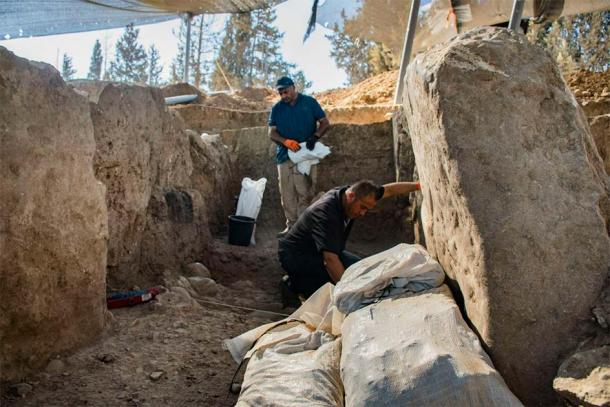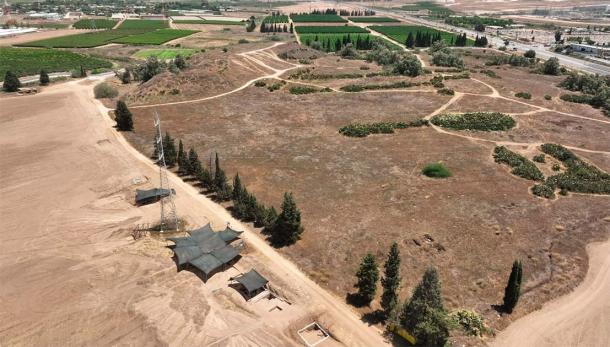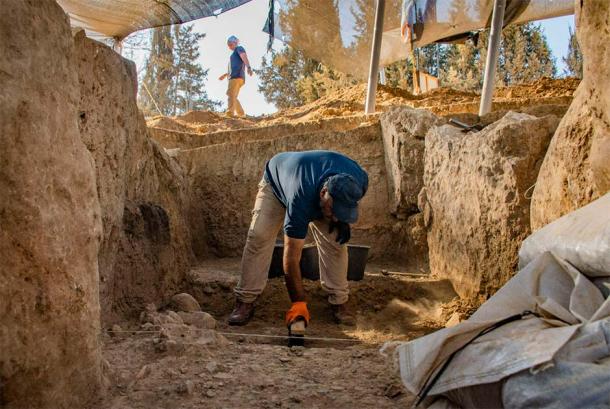
Defensive City Gate Unearthed in Israel Dating Back 5,500 Years
An ancient monumental city gate, at least 5,500 years old, has been discovered at Tel Erani in southern Israel, making it Israel’s oldest gate by centuries! The stone gate structure was built from importing giant stone blocks, with the locally available mudbrick mixed in. At 1.5 meters (4.92 feet) high, it comprises a passageway built of large stones leading into the ancient city, with two stone guard towers flanking it.
Subverting Tradition: A Show of Strength?
Haaretz reported that the method of construction is a deviation from the traditional mudbrick, which was exclusively used for such construction.
“This is the first time that such a large gate dating to the Early Bronze IB has been uncovered,” Emily Bischoff, the IAA’s director of the excavation, said in a video about the gate. The latest excavations at Tel Erani were discovered recently during an IAA survey of the area ahead of laying a new water line to Kiryat Gat. “What’s interesting about this gate is it was built partially from mud bricks and partially from monolithic stones, and these stones are larger than me,” said Bischoff.

The city gate in Tel Erani, Israel, was made with giant stone blocks. Credit: Yoli Schwartz / IAA)
Another IAA researcher, Martin-David Pasternak, an expert in the Levant Bronze Age, explained that the gate likely served as a necessary entrance for all passersby, traders, and even enemies. The impressive height and structure ensured not only a line of fortification and defence, but provided the impression of a prosperous settlement with a strong political and economic center.
This is highlighted by the fact that the construction of the gate likely involved transportation of giant stones across considerable distances, and the production of hundreds, if not thousands, of mudbricks.
This hypothesis is that walling began once the Egyptians began making their presence felt in the region. The latter pottery finds at the site are from ancient Egypt, or from the same style, so it is very likely that the Egyptians were the ones who eventually caused the destruction of the site.
The Tel Erani Site: Compelling Evidence of Urbanization in the Early Bronze Age
The Tel Erani site, fortified in the Early Bronze I period, was one of the southern Levant’s major commercial and economic centers from this time period. It stands as one of Israel's earliest instances of urban development, sprawling across approximately 150,000 square meters (37 acres). This settlement emerged during the Early Bronze Period, around 3,300 BC, and saw its decline by the end of the Early Bronze Period, approximately 2,500 BC.
“This was not achieved by one or a few individuals. The fortification system is evidence of social organization that represents the beginning of urbanization,” explained Dr. Birschoff. “It’s the first time people go from living all over the region to living inside the city walls.”
- Archaeologists Uncover the Gate of Jesus’ Feeding Miracle City
- City Gate From the Time of King David Unearthed In Miracle Village

The Tel Erani excavation site (bottom left). Credit: Emil Aladjem / IAA)
The archaeological excavations at Tel Erani have unveiled compelling evidence of urbanization - public structures, city planning featuring streets and defensive walls, a possible drainage system, and signs of social stratification—indicating varying living conditions based on individuals' social status, reports The Times of Israel.
Prior to this discovery, experts believed that urbanization in this region commenced around 5,200 years ago, coinciding with the age of the oldest known gate in Israel. Up until now, the title of the oldest gate to a fortified city was held by Tel Arad, near Beersheba. However, the dating of the Tel Erani gate pushes back the origins of urbanization by several centuries, to around 5,500 years ago.
Archaeologists also uncovered several smaller artifacts, including a fully intact alabaster jar, numerous juglets, and red-colored bowls. Notably, the fortification wall, which measures 7 to 8 meters (23 - 26.2 feet) in thickness, dating to a time when Egypt was exerting its influence in the region.

Archaeologists excavate the stone city gate in Tel Erani. Credit: Yoli Schwartz / IAA)
These recent excavations have been carried out in anticipation of the construction of a new water line, which is scheduled to commence this year. The National Water Carrier of Israel, Mekorot, aims to provide more water to Kiryat Gat, with a specific focus on catering to the water demands of existing and planned Intel factories in the area.
These facilities require substantial quantities of ultra-pure water for the production of computer chips, including the forthcoming $25 billion investment in a chip manufacturing plant, set to open in 2027. Construction of the water line is expected to commence in the coming months and conclude by 2024, reports Arkeonews.
Top image: Aerial view of the 5,500-year-old gate at Tel Erani, Israel. Credit: Emil Aladjem / Israel Antiquities Authority.
By Sahir Pandey
References
Aton, F. 2023. Archaeologists Find 5,500-Year-Old City Gate in Israel. Available at: https://www.artnews.com/art-news/news/oldest-city-gate-tel-erani-israel-1234677071/.
Lidman, M. 2023. Discovery of Israel’s oldest gate resets clock on local urbanization by centuries. Available at: https://www.timesofisrael.com/discovery-of-israels-oldest-gate-resets-clock-on-local-urbanization-by-centuries/.
Schuster, R. 2023. Archaeologists Unearth Earliest Monumental City Gate in Israel, From 5,500 Years Ago. Available at: https://www.haaretz.com/archaeology/2023-08-15/ty-article/archaeologists-unearth-earliest-monumental-city-gate-in-israel-from-5-500-years-ago/00000189-f837-de6e-a1ff-faff96060000.















